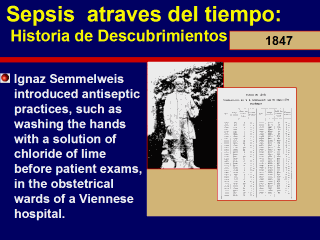| front |1 |2 |3 |4 |5 |6 |7 |8 |9 |10 |11 |12 |13 |14 |15 |16 |17 |18 |19 |20 |21 |22 |23 |24 | 25|26 |27 |28 |29 |30 |31 |32 |33 |34 |35 |36 |37 |review |
 |
Ignaz Semmelweis
was a Hungarian physician who took a post at the Vienna Lying-In Hospital in
the mid-1800s. He noticed that the incidence of puerperal fever was much
higher in the teaching wards for medical students than for midwives. The
independent variable, he realized, was that medical students performed
autopsies and the midwives did not. He introduced antiseptic practices in
the obstetrical wards and reduced the mortality rate of puerperal fever from
13.6% to 1.5%. In 1861, he published his classic work on childbed fever
based on his extremely detailed records from his practice. Wilson RF. A brief introduction to sepsis: its importance and some historical notes. Heart Lung. 1976;5:393–396. Lagassé P, ed. The Columbia Encyclopedia. 6th ed. New York, NY: Columbia University Press; 2000. Dunn DL. History repeats itself: connections and causality in the study of surgical infections. Arch Surg. 1994;129:21–26. Merriam-Webster ’s Biographical Dictionary. Springfield, Mass: Merriam-Webster Inc; 1995.Tavassoli M. Selected items from the history of pathology. Am J Pathol. 1980;101:114. Bynum WF. Science and the Practice of Medicine in the Nineteenth Century. Cambridge, England: Cambridge University Press; 1994. |